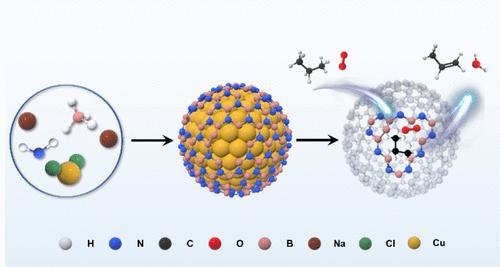利用平面弯曲策略在凸面氮化硼中形成可控缺陷,实现丙烷的高效氧化脱氢反应
IF 11.3
1区 化学
Q1 CHEMISTRY, PHYSICAL
引用次数: 0
摘要
六方氮化硼(h-BN)可以抑制丙烷(ODHP)氧化脱氢过程中的烯烃过氧化反应,但由于在 B 边缘和 N 缺陷处形成的 B-O 活性位点有限,其催化活性本质上较低。在此,我们报告了一种基于平面弯曲的策略,通过金属(铜、铁、钴和镍)纳米颗粒的封装-沉积合成凸面 h-BN。结合 NEXAFS、XPS 和 DFT 计算的结果表明,BN 的平面弯曲形成了大量的缺陷,尤其是 "七硼中心 "N 缺陷,从而产生了大量的 B-O 活性物种,增强了 ODHP。以铜(500 °C)和铁(520 °C)纳米粒子为模板,在 h-BN 中产生这些缺陷后,在 7200 h-1 的 WHSV 条件下,烯烃产率分别为 31.7% 和 37.0%。原位 DRIFTS 和 DFT 计算表明,这些缺陷工程 h-BNs 的高活性源于高效的 C-H 激活和裂解以及在丰富的 B-O 活性位点上形成的 C═C 动力学效应。平面弯曲效应为在 h-BN 上原位生长缺陷以提高 ODHP 提供了途径,从而促进了其在工业催化方面的应用。本文章由计算机程序翻译,如有差异,请以英文原文为准。

Controllable Growing Defects in Cambered Boron Nitride Utilizing a Plane Bending Strategy for Efficient Oxidative Dehydrogenation of Propane
Hexagonal boron nitride (h-BN) can inhibit olefin overoxidation during the oxidative dehydrogenation of propane (ODHP) but shows intrinsically low catalytic activity because of the limited B–O active sites formed at B edges and N defects. Herein, we report a strategy based on plane bending to synthesize cambered h-BN by the encapsulation–elution of metal (Cu, Fe, Co, and Ni) nanoparticles. Combining the results of NEXAFS, XPS, and DFT calculations, it was shown that large numbers of defects, especially the “seven-boron center” N defects, were formed by plane bending of BN, resulting in a large number of B–O active species for enhanced ODHP. The creation of these defects in h-BN resulted in 31.7% and 37.0% olefin yields under a WHSV of 7200 h–1 using Cu (500 °C) and Fe (520 °C) nanoparticles as templates, respectively. In situ DRIFTS coupled with DFT calculations showed that the high activity of these defect-engineered h-BNs resulted from highly efficient C–H activation and cleavage and the kinetics-favorable formation of C═C on abundant B–O active sites. The plane bending effect provides a way for in situ growth of defects on h-BN to enhance the ODHP, which promotes its industrial catalysis applications.
求助全文
通过发布文献求助,成功后即可免费获取论文全文。
去求助
来源期刊

ACS Catalysis
CHEMISTRY, PHYSICAL-
CiteScore
20.80
自引率
6.20%
发文量
1253
审稿时长
1.5 months
期刊介绍:
ACS Catalysis is an esteemed journal that publishes original research in the fields of heterogeneous catalysis, molecular catalysis, and biocatalysis. It offers broad coverage across diverse areas such as life sciences, organometallics and synthesis, photochemistry and electrochemistry, drug discovery and synthesis, materials science, environmental protection, polymer discovery and synthesis, and energy and fuels.
The scope of the journal is to showcase innovative work in various aspects of catalysis. This includes new reactions and novel synthetic approaches utilizing known catalysts, the discovery or modification of new catalysts, elucidation of catalytic mechanisms through cutting-edge investigations, practical enhancements of existing processes, as well as conceptual advances in the field. Contributions to ACS Catalysis can encompass both experimental and theoretical research focused on catalytic molecules, macromolecules, and materials that exhibit catalytic turnover.
 求助内容:
求助内容: 应助结果提醒方式:
应助结果提醒方式:


